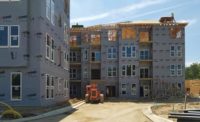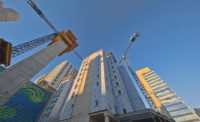In the last 10 years, severe weather has become the new normal in building construction. Damage from hurricanes, tornados, hail, floods and blizzards totaled more than $13 billion in 2013 according to the National Weather Service.
Contractors, architects and manufacturers for all building types are seeking durable exterior materials to protect their properties from the elements. That is why construction professionals are turning to fiber cement products—rather than vinyl or wood—to outfit the exterior of commercial, multi-family, institutional and industrial structures.
Severe Weather Challenges in Exterior Wall Construction
Vinyl and wood siding are both susceptible to fires, as evident by the wildfire destruction in California, for example. The “King” fire began Sept. 13, 2014 and spread to more than 95,350 acres across the Northern California countryside. That’s larger than the cities of Las Vegas, Atlanta or Philadelphia.
Despite the efforts of nearly 8,000 firefighters, the blaze destroyed approximately 69 buildings, and threatened nearly 300 more, according to the California Fire Department. Experts predict more than $50 million in damages before all of the flames are extinguished. The King fire is one of more than 5,000 fires in California last year, a 26 percent increase over 2013, the National Fire Protection Association reported.
In Colorado, severe floods swept through 17 counties in September 2013. About 2,000 residences were destroyed, costing homeowners $900 million, according to estimates from the loss analysis firm Eqecat. One of the worst cities affected, Boulder, had its 25 square miles inundated with more than 4.5 billion gallons of water, the Denver Postreported.
However, the most devastating and costly natural disaster in the last few years far surpasses fire and flooding. Hurricane Sandy destroyed parts of the New York and New Jersey coastlines in October 2012. Experts from the National Hurricane Center estimated preliminary damages of $50 to $65 billion, making it the second-costliest hurricane since 1900.
With the threat of fire, flooding and hurricanes in mind, construction experts are looking for exterior wall systems that can stand up to severe weather. In the 1950s housing boom, builders relied heavily on vinyl and wood siding for single and multifamily homes. However, with the advent of fiber cement products, in the 1980s, contractors quickly found that the sand, cement and cellulose fiber mixture was a more durable substrate than both wood and vinyl.
Standing Up to Debris, Flames and Flooding
Wind and debris damage are major concerns in the hurricane and tornado-prone areas of the country. During high-wind events, which the Federal Emergency Management Agency describes as anything greater than 90 mph, siding is frequently blown off commercial and residential structures.
The National Storm Damage Center warns that while vinyl siding is low maintenance, storms can cause serious damage to the material, leaving a structure unprotected from the elements. The most common types of damages are:
- Cracking: Splits or cracks that run parallel to the siding and are most commonly found between the valley and ridges of the panel.
- Chipping: Discover chipping by looking up from underneath a panel section. Contractors will notice a semi-circle toward the bottom of the ridge, where it has no flexibility to absorb direct contact.
- Breaking and holes: Severe storms that have hail or flying debris can cause breakage and holes in vinyl siding.
While storm damage is a concern with vinyl siding, fire can devastate wood siding. In areas with a high risk of wildfire, the combustibility of exterior walls becomes extremely important.
The rustic aesthetic of wood is attractive to both contractors and architects in rural areas, but the U.S. Forest Services advises against using wood siding that hasn’t been treated with a fire-retardant. Many structural fires “have started by direct ignition of external wood siding, garage doors and porches,” the agency warns.
A large fire produces enough heat to easily melt vinyl siding at a distance of 40 feet and in some cases, ignite it, according to fire engineers. When vinyl siding does burn, it releases toxic fumes.
For new building construction, FEMA recommends exterior wall systems with at least a 1-hour fire-resistance rating. This refers to the time a structure confines a fire and continues to perform its function. Vinyl and wood siding that are not treated with a fire-retardant do not meet this 1-hour benchmark and are not recommended by FEMA.
ASTM E-119 is the standard test method for determining the hourly fire resistance rating of a wall assembly. During this test, researchers use a controlled flame beginning on one side of a wall system. The test runs to a target fire resistance rating time, a classification such as 1-hour or 2-hours. The wall system is checked throughout the fire exposure time to make sure:
- The wall has sustained the applied load during the test without passage of flame or gases hot enough to ignite cotton waste.
- The wall sustained the applied load during the fire and hose stream test, without passage of flame, of gasses hot enough to ignite cotton waste, or of the hose stream.
- The wall does not allow the hose stream to project beyond the unexposed surface during the time of the hose stream test.
- The walls unexposed surface temperature does not raise more than 250 degrees Fahrenheit above its initial temperature.
The fire-resistance rating is determined by number of hours that elapse before one of the above outcomes occur. Most fiber cement products manufacturing companies have 1 or 2-hour fire-resistant ratings and note non-combustibility as a key advantage in choosing this type of exterior wall system for multifamily or commercial structures.
Just as FEMA attempts to prevent structural damage from fires, the agency also suggests regulation in respect to floods, rating building materials according to their water resistance. The strongest level of building materials, Class 5, is defined as, “highly resistant to floodwater damage, including damage caused by moving water. These materials can survive wetting and drying and may be successfully cleaned after a flood to render them free of most harmful pollutants.”
Only Class 4 and Class 5 materials can be used for areas below a building’s base flood elevation if located in a flood hazard area. Most fiber cement is siding is listed as a Class 5 building material. This means that the product can withstand a 72-hour flood event and be reused after drying. In contrast, vinyl siding can tolerate some water exposure, but submersion completely destroys wood siding.
Severe Weather Changing National Building Codes
Natural disasters often act as the catalyst for national and regional building code changes. The International Building Code is the most widely adopted model code in the U.S., reviewed and modified on a three-year cycle. The 2015 version of the IBC was released earlier this year.
Both flooding and storms had a large influence in IBC revisions in 2012. Exterior walls that extend below a certain elevation, defined Section 1612, must be constructed with materials that are resistant to flood damage. This limits the use of wood siding unless it is pressure-preservative treated. Due to increased storms in the last two years, experts predict that flooding will likely have more rigorous codes in the 2018 IBC.
Combustibility, water resistance and wind load are all factors that come into play depending on the geographic location of a project.
Some manufacturers engineer their materials based on the climate of an area, taking into consideration temperature range, rain, hurricanes and topographical features. For example, exterior and trim products from James Hardie that are developed for its HZ5 product zones, including the Northeast and Midwest, are formulated to protect against wet or cold conditions while products for the South safeguard against wind and extreme heat. The advantages of using fiber cement products are only increasing as the threat of more frequent severe weather looms.
Contractors, architects and other professionals must evaluate not only the aesthetic and market standards when choosing exterior products but also how the siding will hold up to natural disasters in an area in which a residence, commercial or institutional building is located.






Report Abusive Comment